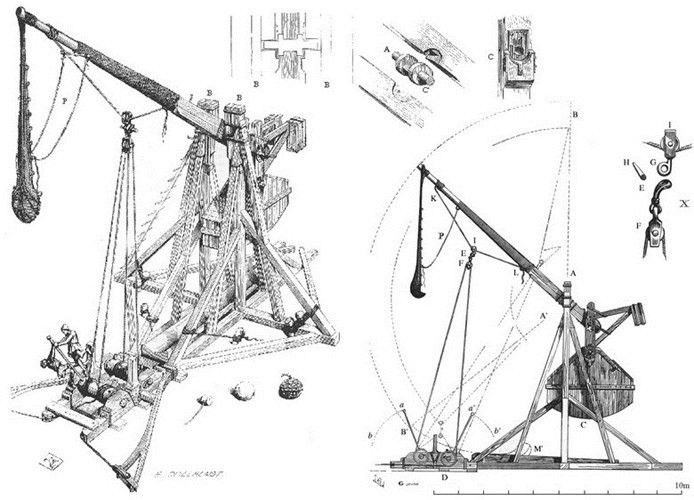The Best Diets for Heart Health

In addition to regular exercise and not smoking, diet is one of the best ways to protect your heart. Here are the best diets for heart health.
Catapults were the main offensive weapon in the Middle Ages. Are you curious about the design of a catapult ? Let's find out together!
A catapult was a device used in warfare and sieges during the Middle Ages. It could be used to throw rocks at ramparts in an attempt to breach them. It could also be used to throw objects over the walls of a city, such as animal carcasses. The catapult is also commonly known as a Trebuchet.
The catapult works in a simple way. The basket of the weapon is filled with heavy rocks. It acts as a counterweight for the other end, which is usually filled with a large rock. Some people mount the catapult arm by raising the counterweight and lowering the shooting arm. At this point, the arm is released, the basket swings down, and the arm swings up, shooting the rocks far and fast. The sling adds 10-15 feet to the length of the arm and gives the projectile a quick rebound and release. The sling provides the projectile with most of its speed.
Now let's learn more about catapults!
What is a catapult?
A catapult is a machine used as a weapon to throw rocks or other objects such as hot tar, which can cause damage to other objects. Usually, catapults are placed on higher ground or on castle towers to be able to shoot farther. They shoot rocks to break down castle walls, or shoot regular or hot tar to burn the target.
Catapults used weights and levers to launch rocks or other objects into the air. They did not project as far as modern weapons, and were not useful in modern warfare. Catapults were very common in the past, especially in the Middle Ages.
A catapult typically had two wooden arms attached to a length of rope. The rope was made of human or animal hair. The rope was attached to a winch and
pulled backwards, bending the arms backwards.
The trebuchet was a siege weapon that dominated medieval battlefields for several centuries until the advent of gunpowder weapons.
The catapult operates on the mechanical principle of leverage. The structure of the machine consists of a hanging rope, a lever arm and a heavy counterweight. When the lever arm and the hanging rope swing into a vertical position, the bullet at the end of the hanging rope is launched and flies towards the target with terrible force, capable of breaking apart many solid stone walls.

Large catapults can hurl rocks weighing up to 140kg about 300m away. In fact, history has recorded giant machines that can hurl rocks weighing 1.5 tons. With this ability, catapults are extremely dangerous and highly destructive weapons. However, they only truly unleash their terrible destructive power when besieging a city.
In addition to stone bullets, catapults were also used to hurl fireballs at enemy strongholds, playing an important role in many major battles.
A replica of a trebuchet catapult is located in Beckdorf, Lower Saxony, Germany. Weapons expert Mike Loades decided to test the power of this machine. To operate this medieval siege weapon, Mike Loades needed the help of a whole team.
In this test, large wooden stakes were set up as targets. The stone was fired from the machine and hit the target, causing the wooden stakes to collapse like matchsticks. For details on the test of the destructive power of the 12th century catapult, please watch the video below.
In addition to regular exercise and not smoking, diet is one of the best ways to protect your heart. Here are the best diets for heart health.
Diet is important to our health. Yet most of our meals are lacking in these six important nutrients.
At first glance, AirPods look just like any other true wireless earbuds. But that all changed when a few little-known features were discovered.
In this article, we will guide you how to regain access to your hard drive when it fails. Let's follow along!
Dental floss is a common tool for cleaning teeth, however, not everyone knows how to use it properly. Below are instructions on how to use dental floss to clean teeth effectively.
Building muscle takes time and the right training, but its something anyone can do. Heres how to build muscle, according to experts.
The third trimester is often the most difficult time to sleep during pregnancy. Here are some ways to treat insomnia in the third trimester.
There are many ways to lose weight without changing anything in your diet. Here are some scientifically proven automatic weight loss or calorie-burning methods that anyone can use.
Apple has introduced iOS 26 – a major update with a brand new frosted glass design, smarter experiences, and improvements to familiar apps.
Yoga can provide many health benefits, including better sleep. Because yoga can be relaxing and restorative, its a great way to beat insomnia after a busy day.
The flower of the other shore is a unique flower, carrying many unique meanings. So what is the flower of the other shore, is the flower of the other shore real, what is the meaning and legend of the flower of the other shore?
Craving for snacks but afraid of gaining weight? Dont worry, lets explore together many types of weight loss snacks that are high in fiber, low in calories without making you try to starve yourself.
Prioritizing a consistent sleep schedule and evening routine can help improve the quality of your sleep. Heres what you need to know to stop tossing and turning at night.
Adding a printer to Windows 10 is simple, although the process for wired devices will be different than for wireless devices.
You want to have a beautiful, shiny, healthy nail quickly. The simple tips for beautiful nails below will be useful for you.













